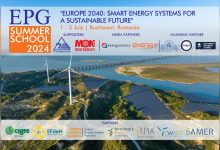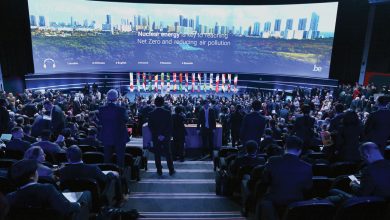Energy Tech Day 2024 – Empowering Energy Transition: Pairing Technology with Sustainability
Romania’s leading energy technology event & networking platform Energy Tech Day (ETD) – Empowering Energy Transition: Pairing Technology with Sustainability was held on April 17-18, at JW Marriott Bucharest Grand Hotel.
This 5th edition of the ETD was designed to focus on the newest sustainable approaches to decarbonising the energy sector through smart strategies, innovative technologies and concepts, digital tools, and available mechanisms.
With a dedicated technical programme, the event set the scene for energy experts to share their perspectives, inspiring presentations, and alternative viewpoints.
Energy Tech Day 2024 brought together international professionals, national government authorities, clean energy leaders, investors, business owners, technology developers across the entire energy value chain to explore new opportunities and challenges on the path to sustainability.
Oana-Marciana Özmen – Secretary, Committee for Industries and Services at the ROMANIAN PARLIAMENT, stressed the role of hydrogen in energy decarbonisation scenarios. She reiterated the importance of attracting available European funds, access to technology and supporting industry through coherent public policies to enable the decarbonisation process. The use and production of hydrogen and alternative fuels, digitalisation and training of specialists will play a decisive role in Romania’s economic future, she underlined.

For his part, Dan-Dragos Dragan – Secretary of State in the ROMANIAN MINISTRY OF ENERGY, highlighted the major actions of the National Energy Strategy vision 2030, focusing on decarbonisation and concrete steps towards a sustainable future. He noted that Romania has committed to the net zero target by 2050 and mentioned the three pillars for achieving this goal: renewable energy, nuclear energy, and gas as a transition fuel.

Maria Manicuta – Director General of Network Tariff and Investment Monitoring at the ROMANIAN REGULATORY AUTHORITY FOR ENERGY, insisted on the security of electricity and gas grids and the accommodation of renewable energy sources. She also mentioned hydrogen as a balancing source for the energy system and as an electricity storage option.

ROMANIA ENSURES ACCESS TO AFFORDABLE, RELIABLE, SUSTAINABLE AND MODERN ENERGY
Raluca Alexandra Covrig – Director of Public Affairs and Communication of the OIL AND GAS EMPLOYERS’ FEDERATION (FPPG) – mentioned some relevant data on the oil & gas history in Romania. As we all know, oil & gas activities in Romania cover a long-time span, from ancient times to the present. Her presentation showed how FPPG, founded in 1991, advocates for the industry through a mass public education platform called ‘Viitorul energiei’ (The Future of Energy). The platform focuses on 10 key pillars namely Geothermal, CCS, Hydrogen, Biofuels, Offshore Wind, Nuclear, Photovoltaics, Natural Gas & Biomethane, Hydropower and Hydrocarbons. In its policy papers, the FPPG elaborates on the significant activities mentioned above in the energy sector.

Screening and ranking carbon storage sites were the key topics of Slobodan Stojic – Principal Reservoir Geologist at SLB – a company with 100+ years of global subsurface knowledge, developed over two decades of storage projects and 100+ projects worldwide. He explained the main reasons why screening and ranking are so important in starting a CCUS project. This type of work not only confirms whether CCUS is an option for decarbonisation, but also determines the most appropriate site to ensure the success of a storage project, provides great value at a low cost, validates which storage sites deserve further evaluation for project viability, and provides a fundamental foundation for a successful storage project. Not to mention the fact that there are many factors to consider when selecting the right site the first time.
Vladislav Atanassov – Senior Advisor Business Development, Exploration and Production at OMV PETROM, continued the discussion on CCS technology, focusing on opportunities and challenges. He revealed the OMV Petrom Strategy 2030: Transforming for a lower carbon future. In terms of carbon capture, utilisation & storage, Romania needs to assess the potential for long-term on- and offshore CO2 storage. Based on an in-depth knowledge of Romania’s geological structures, CCS technology represents a step-by-step approach to drive the transition to a low-carbon economy. Potential partnerships with hard-to-abate industries and testing of CO2 capture and utilisation technology in refineries should also be considered.
The strategic role of underground gas storage in the energy security of Central and Eastern Europe was emphasized by Vasile Carstea – General Manager of DEPOGAZ, the main underground gas storage operator in Romania. The company has an extensive experience in this field, holding a share of about 90.54% of the country’s total active storage capacity. DEPOGAZ holds a license for the operation of 5 underground natural gas storage facilities, developed in depleted gas fields, whose cumulated storage capacity rises up to 2,870 million Scm/cycle, the facilities being positioned in various geographical areas of Romania. Currently, DEPOGAZ promotes five development projects, modelled in relation to the requirements of the European gas market and included in TYNDP 2022.
We learned about the right approach to successful decarbonisation for the upstream Oil & Gas sector from Adrian Staicu – Business Development Manager at XP, an oil and gas operator with a strong track record of enhancing production and decarbonising operations. The Upgreen model of the company aims to reduce environmental footprint and GHG emissions by implementing the proven cost-effective technical solutions. XP has implemented dozens of GHG emission reduction projects to reduce emissions in three key categories: Fugitive, Venting and Flaring. Over the past 18 years of operatorship and investment in mature field improvements, XP has deployed dozens of field-proven solutions to measure, report and reduce the environmental footprint of its operations and build a strong track record.
Focusing on sustainable solutions for the energy sector, Florina Ciulei – Marketing Representative at INCDT COMOTI, the renowned Romanian Research & Development Institute for Gas Turbines, brought some novelties in the field. This is about multirole drones. For example, the UAV ENFORCING – Forest Eagle, is developed as part of a research project with the aim of designing an experimental fixed-wing drone model that includes an innovative tri-rotor system with vectorization capabilities, enabling both vertical take-off and landing (VTOL) and cruising flight. The drone’s mission is to survey forests to identify illegal deforestation. This is made possible with the help of 4 microphones that can, using artificial intelligence, identify areas where thermal-powered chainsaws are in use. After identifying the deforested area, photos and videos will be captured with the onboard camera for subsequent submission to the authorities to verify legality.
CHIMCOMPLEX is Romania’s largest chemical producer, operational since 1954. During the first panel of the ETD, Narcis Floricioiu – Deputy Technical Development Director, talked about energy efficiency and sustainability in the chemical industry. The company continuously invests in new technologies to increase efficiency while keeping environmental protection and sustainability at the heart of its strategy. Chimcomplex has built one of the most modern gas turbine combined heat and power (CHP) unit, in compliance with the latest international energy efficiency standards and directives (BAT). The power plant replaced a pre-existing coal-fired power plant – CET Govora, operating since 1959, and reduced carbon dioxide emissions by 67%. The CHP 49.5 MW gas-fired power plant uses 3 highly efficient gas turbines for power generation PGM130 Generator Set, powered by Solar’s Titan 130 Gas Turbine. The company also implemented the project ‘High-Efficiency Cogeneration Plant’ with a capacity of up to 8 MWe at Chimcomplex S.A. Borzesti – Ramnicu Valcea Branch. This project aims to make an investment within the Large Infrastructure Operational Programme (LIOP), Priority Axis 6 Clean energy and energy efficiency in order to support a low carbon economy, Specific Objective 6.4 Improving energy efficiency in industry by promoting consumption of energy produced in high-efficiency cogeneration systems.
MAKING DECARBONISATION POSSIBLE WHILE MAINTAINING SECURITY OF SUPPLY
The most important energy-consuming infrastructures and those contributing most to GHG emissions are the power and transport systems. Technological alternatives for generating, transporting, and converting energy for power and transport systems are numerous. Cornel Zeveleanu – Director Corporate Affairs & European Funds at E.ON ROMANIA, addressed the interdependence between energy infrastructure and alternative technologies, including the high potential of prosumers in covering energy consumption. As active participants in both energy production and consumption, they play a pivotal role in reshaping conventional energy paradigms. Due to their energy intensity, industrial prosumers are important players in the energy transition. In his speech, Cornel Zeveleanu also referred to the long-term national strategy to reduce greenhouse gas emissions, which aims to make Romania neutral by 2050.

Mihai Marcolt – Head of Research & Innovation Office at TRANSELECTRICA, provided effective data and figures on the company’s research and innovation projects, with a focus on the development of the Romanian High Voltage Grid. To ensure the convergence of European and national objectives, Transelectrica has defined and validated a set of strategic documents to support the vision and ambitions as a high-performing grid operator. The digital transition is ready to be implemented in research and innovation projects and digital transformation programmes, setting ambitious targets that will have a substantial impact on the services provided. Specifically, the projects defined within the DigiTEL portfolio will optimise and digitise numerous operational processes that support specific decisions on operation, maintenance, network planning, network observability, decarbonisation, and safety. This portfolio will positively influence the long-term performance of the company, leading to solid and sustainable growth in response to direct and indirect opportunities that may arise from national and European programmes.
Located in 90 countries, SIEMENS ENERGY operates across the whole energy landscape. From conventional to renewable power, from grid technology to storage to electrifying complex industrial processes. The company’s mission is to support companies and countries with what they need to reduce greenhouse gas emissions and make energy reliable, affordable and more sustainable. Speaking of security of supply, Petru Ruset – Managing Director of the company, revealed five uncomfortable truths about the energy transition. Firstly, expanding renewable energy sources is not possible without expanding the use of bridge technologies such as hydrogen-capable gas turbines. Secondly, RES are volatile, needing complicated technologies and are still expensive. Thirdly, the hydrogen technology is not mature enough. Moreover, the renewable energy sources accommodation is overcharging the power grid. In the end, the energy system requires partners. Energy transition is an immense task and needs to pitch in: business, politics, and society.
Challenges and opportunities facing the new wave of renewables in Romania were debated by Zoltan Nagy-Bege – Energy Market Department Director at CIGA ENERGY. In his view, a major challenge at the moment is the price of energy, while opportunities lie in accessing available European funds. CIGA ENERGY has been present in the electricity and gas market since 2011. The company’s activities include consultancy and assistance services to private utility companies and public authorities in Romania. CIGA Energy assists clients in the digital transformation of industrial and utility companies, both as a consultant and as an integrator. CIGA Energy also provides Balancing Responsible Party (BRP) representation services for participants in the balancing market, where it represents 30% of consumption and 80% of renewable energy in Romania.
Daniel Vlasceanu – Partner, VLASCEANU & PARTNERS, presented the key aspects of the Modernisation Fund, set to be opened on April 25th, 2024. A significant support scheme, the call is designed to support private and state-owned companies with the CAPEX burden of RES facilities from wind, PV, and hydro. The Modernisation Fund includes, among others, approved financing: EUR 900mn for CE Oltenia projects; EUR 2bn for Transelectrica and EUR 1.3bn for DSO(s); EUR 2.3bn for supporting the CAPEX for RES facilities; EUR 3bn for the CfD Scheme. According to him, there are some important elements worth mentioning, such as: expenditure incurred before the submission of the Financing Application is not eligible; completion of investments by 31 December 2026; unitary nature of the project; if the Modernisation Fund scheme is not fully consumed, the Ministry will organise a new bidding; possibility of budget redistribution.
Catalin Stancu – Associated Senior Expert at HORVÁTH, showed that Romania’s National Hydrogen Strategy considers green H2 as a key element for decarbonisation in several sectors. He believes that the implementation of hydrogen projects will make a significant contribution to Romania’s 2030 decarbonisation target. Thus, the demand for green H2 in Romania is estimated at 153 thousand tonnes by 2030, reducing carbon emissions by 2 million tonnes of CO2. Also, most of the main components of the levelized cost of hydrogen point to a decrease in cost over the next decade. Following the preliminary analysis and based on the criteria applied, five areas with potential to become hydrogen valleys have emerged: Bucharest – Ploiesti – Targoviste – Pitesti; Constanta – Medgidia – Calarasi – Slobozia; Cluj – Targu Mures – Sighisoara – Sibiu – Sebes; Galati – Braila – Tulcea; Craiova – Slatina – Targu Jiu.
CUTTING-EDGE PROGRESSES: PAIRING TECHNOLOGY WITH SUSTAINABILITY
During the last panel of the conference, Mihnea Zamfir – Head of Strategy and Sustainability at E.ON ROMANIA, highlighted Delgaz Grid’s climate neutrality approach to achieving a sustainable future. These include hybrid solutions such as network smartification, digitalization of core processes, introduction of new technologies, flexibility – the energy system’s ability to adapt quickly to changes in energy demand and supply. For instance, the company’s flagship project – 20HyGrid, aims to integrate hydrogen into existing gas pipelines, aligning with decarbonisation targets. It makes use of existing infrastructure, facilitating the transition to hydrogen, and reducing investment costs and emissions, thereby promoting energy sustainability and climate change mitigation. The benefits consist of significant reduction in greenhouse gas emissions, confirming the results of similar European projects (compatibility of up to 30% vol. H2 in NG), as well as the absence of any technical risk in the operation of the distribution network. Other current implementations and future prospects mentioned were: E.ON Home Stage, Flexibility and BESS storage systems, Embedding artificial intelligence into core processes.

SOLAX POWER is a global leader in solar inverter technology, manufacturing products that are renowned for their reliability, efficiency, and affordability. The company delivers innovative energy solutions for homeowners, businesses and utilities, their product range incorporating the latest innovations in solar energy. In his presentation, Robert Kenderessy – Regional Sales Manager Balkans Area, drew attention to advanced battery technologies and the new SolaX Power product released in 2024. The advantages of the proposed solution are diverse application scenarios, superior capacity, robust safety, high versatility, smart energy management, all-in-one design. All products are developed and manufactured exclusively by SolaX, including hybrid inverters, storage batteries, BMS. From manufacturing to after-sales support, the company provides high-quality products and services.
Alexandru Chirita – Chief Executive Officer of ELECTRICA, talked about smart grids and the digital transformation of the electricity network in Romania. He stressed the importance of cooperation between all actors in the energy sector to promote the development of green energy and energy storage solutions. In this context, strategic investments are key to achieving Romania’s ambitious climate and energy targets for 2030 and 2050. Moreover, rapid market changes will require a high level of adaptability and resilience, which are essential for innovation and success in a world where technology plays a key role.
The European Investment Bank’s financing and advisory support to sustainable projects was underscored by Matthieu Banal – Innovation Finance Advisory at the EUROPEAN INVESTMENT BANK. The world’s largest multilateral lender and largest provider of climate finance supports small businesses while enhancing climate action and innovation and also focusing on energy transition and urban sustainability. In 2023, Romania received from the EIB Group dedicated funds in 4 areas of interest: EUR 1,024m for Sustainable Cities and Regions; EUR 1,016m for Sustainable Energy & Natural Resources; EUR 78m for Innovation, Digital & Human Capital, and EUR 2,008m for SMEs & Mid-cap finance.
Robert-Ernest Cruceru – Attorney at Law at CRUCERU LAW FIRM, offered valuable insights into the EU Electricity Market Reform, focusing on the main triggers for the process. The energy market context has revealed shortcomings (impact of high and volatile fossil fuel prices on short-term electricity markets). Other key factors are the exposure of households and businesses to significant price spikes, the reduced independence of the EU electricity market from external factors and the need to accelerate the deployment of RES-E. Among the solutions, he mentioned large-scale deployment of offshore renewables; energy market integration – minimum 15% interconnectivity; energy efficiency – could reduce the need/cost for grid and generation capacity expansion; limited grid capacity could be mitigated by increased transparency of available capacity; transparent information on the progress of connection requests. Unfortunately, Romania continues to struggle with constant changes in primary legislation, procrastination/bureaucracy at the level of authorities, reduced transparency when important legislative packages are adopted, convoluted legislative norms – Robert Cruceru concluded.
The last panel ended with a presentation dedicated to smart distributed clean energy technologies. SIGMA STRUCTURES is a globally recognised and well-established partner and supplier of PV structures for utility-scale plants. With a remarkable track record, Sigma has been a trusted industry leader since its inception in 2012. The company emerged as a spin-off of Sigma Energy, a pioneering entity in solar thermal systems that has been active in the field since 1983. Evangelos Samouil – Business Development Executive at SIGMA STRUCTURES, explained how the PV market in Greece has progressed and what the company’s plans are for the upcoming period. In his view, without storage there can be no effective energy transition.
At the end of the day, maybe we should take some time and reflect on our actions taken towards sustainability and why does it matter.







